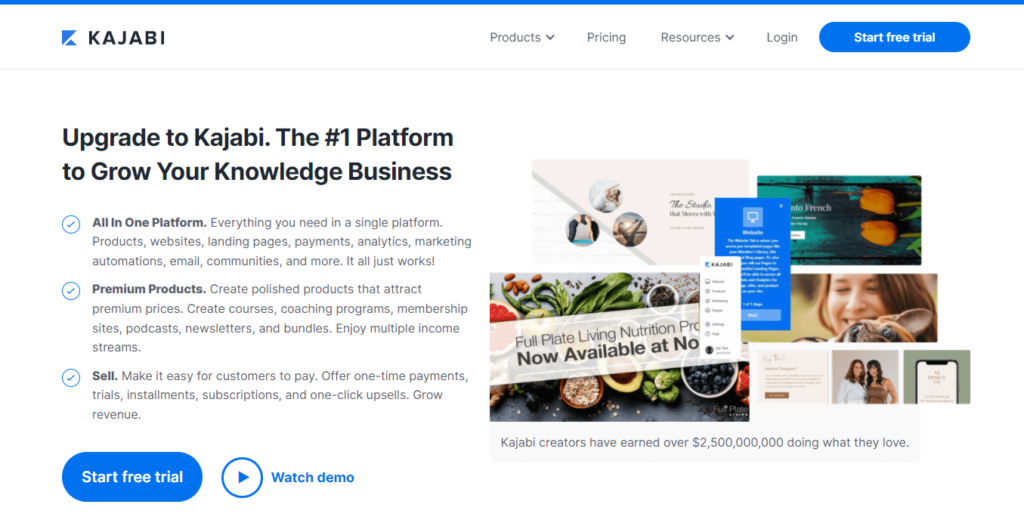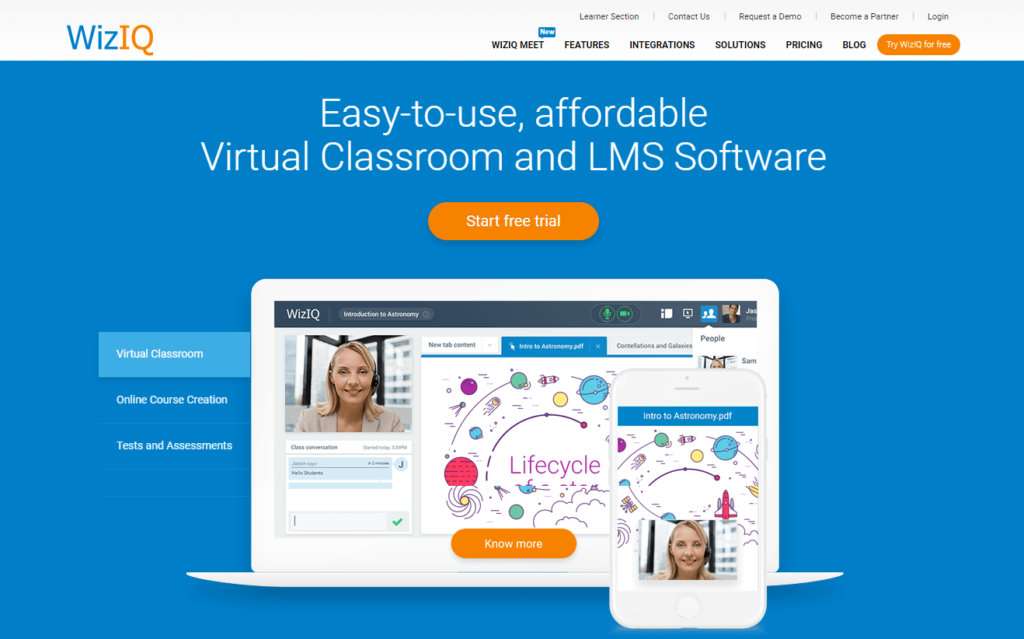Online education has revolutionized the way students learn in this digital world. Students want to enhance their professional knowledge so they can gain more expertise in their respective fields.
Courses provide the best knowledge and skills to enhance professional expertise and so online courses have gained more popularity than traditional educational services. It provides various opportunities to students globally, allowing them to learn anywhere and at any time.
To teach online courses, Web-based learning platforms are widely used.
Designing courses, sharing them with students, and earning revenue are the most common tasks performed by online course instructors using Web-based tools.
There are various online course platforms, but today we’ll discuss the top 7 best platforms to create and sell online courses.
Table of Contents
What Are the Best Online Course Platforms?
The 7 best online course platforms in my experience going from a complete beginner in this field to a teacher in a year.
1. Thinkific

Thinkific is great because it has a student dashboard that shows them their progress and upcoming lessons. This way students can see how much they have to study and what they need to study. It also keeps track of lectures watched, quizzes taken, and lessons completed which is great for accountability.
It’s also extremely affordable and allows students to pay monthly or purchase a yearly plan. They also have a student app which is very helpful.
Pros & Cons of Thinkific
Pros:
- Relatively easy to use
- Offers a free and paid plan
- Can create an unlimited number of courses
- Has a built in payment system
- Can offer courses for free or for sale
- Courses can be drip fed
- Can offer coupon codes
Cons:
- The free plan is quite limited
- Not as many features as some of the other platforms
- Some users have reported issues with customer support
- Content cannot be exported off the platform
Pricing
- Free ($0/month): Great to test out the features and get a feel for the interface.
- Basic ($39/month): Unlimited courses and students, drip (scheduled) content, custom domain, email integrations, and coupons.
- Pro ($79/month): Basic features, plus memberships and bundles, private courses, certificates, advanced HTML and CSS editing, assignments, live lessons via Zoom, and priority support.
- Premier ($399/month): Pro features, plus 50-course admins, onboarding package, and unlimited growth package (best for big teams).
Overall, I recommend the Thinkific platform as our #1 choice for course creators and entrepreneurs who are serious about creating, marketing, and selling their own course content.
You can get started today with a One-Month Free Trial of their Pro Plan with my link below.
2. Kajabi

Kajabi is next on my list because it has a lot of great features. On the plus side, it has a student app which makes it easily accessible for students. It also allows your lessons to be accessed from any computer or electronic device.
You can have 3 free websites with it and each one can have up to 500 pages! Another great thing is that it also has a Facebook group which is great for accountability.
Where Kajabi really excels is in its marketing automation tools. You can segment users in your list, send emails at certain times based on advanced triggers, and send professionally branded messages.
Pros & Cons of Kajabi
Pros:
- Kajabi is very easy to use
- You don’t need any technical skills to create a course
- Kajabi has a great customer support
- There is no limit to the number of courses you can create
- You can host your courses on your own domain name
- You can sell courses in multiple languages
Cons:
- The price is higher than some other platforms
- You can’t host your courses on your own domain name (you have to use a subdomain)
- Kajabi doesn’t have as many features as some other platforms
Pricing
Kajabi pricing is mainly based on the number of courses and active members you have:
- Basic ($119/month): 1 website, 1 admin, 3 products, 3 pipelines, 10,000 contacts, and 1,000 active members.
- Growth ($159/month): 1 website, 10 admins, 15 products, 15 pipelines, 25,000 contacts, and 10,000 active members.
- Pro ($319/month): 3 websites, 25 admins, 100 products, 100 pipelines, 100,000 contacts, and 20,000 active members.
If you’re an established business and want to try one of the more advanced platforms on the market, Kajabi is a solid choice.
Start your free 14-day trial of Kajabi today.
3. Teachable

Teachable allows for easy-to-use pop-up quizzes that are great for keeping students on track. It also has a student app that helps with accessibility.
One of the best things about Teachable is the fact that you can earn 40% of recurring revenue from your courses! This way you get paid even after you have finished the course.
It also has a referral program that allows students to earn money for referring other students which is great!
Pros & Cons of Teachable
Pros:
- You can host your courses on your own domain name
- Teachable has a lot of features
- The price is lower than some other platforms
- You can sell courses in multiple languages
Cons:
- Teachable is not as easy to use as some other platforms
- You need some technical skills to create a course
- Teachable doesn’t have great customer support
Pricing
- Basic ($29/month): 5% transaction fees, 2 admin users, drip content, course builder, members-only community.
- Pro ($99/month): Basic features, plus no transaction fees, 5 admin users, advanced reports, and course certificates.
- Business ($249/month): Pro features, plus advanced coding customizations, 20 admins, bulk student enrollments, and group coaching calls.
Get a free 30-day trial of the Teachable Pro Plan with my link below and start building your interactive online community.
4. Podia

Podia is probably what I would recommend to most people because it has great features and an easy-to-use interface.
It has a student app that can help with accessibility and you can track your student’s progress through the dashboard! On top of that, they offer an affiliate program where you get a 20% commission on recurring revenue from your courses! Podia also has a referral program as well as course bundles to help you make money.
Pros & Cons of Podia
Pros:
- You can host your courses on your own domain name
- Podia has a 14-day free trial
- There is no transaction fee
- You can sell courses in multiple languages
- Podia has a built-in email marketing tool
Cons:
- Podia is a bit more expensive than some other platforms
- You need to have some technical skills to use Podia
- Podia doesn’t have as many features as some other platforms
Pricing
- Mover ($39/month) – Unlimited everything, zero transaction fees, sell courses, digital downloads, and 5k emails sent per month.
- Shaker ($79/month) – Everything in Mover, plus the ability to create membership communities, add affiliates, and 15k emails sent per month.
- Earthquaker ($179/month) – Everything in Shaker, plus a dedicated account manager, personalized onboarding, and 50k emails sent per month.
Overall, if you’re looking for strong membership functionality and the ability to increase your sales with the help of affiliates, Podia is a unique and worthwhile course builder to try out.
You can sign up and give it a test run with a free 14-day trial.
5. LearnDash

This is actually the platform I use for my online course. It has some great features, though not all are free.
There is a free version that still has a lot of great features! You can track your student’s progress through the dashboard, create quizzes to test their knowledge, and many more. The student app is free as well which is amazing!
On top of that, it also allows for affiliate marketing where you get a 10% commission on recurring revenue from your courses.
Pros & Cons of LearnDash
Pros:
- LearnDash is very easy to use
- You can host your courses on your own domain name
- LearnDash has a great customer support
- You can sell courses in multiple languages
Cons:
- The price is higher than some other platforms
- LearnDash doesn’t have as many features as some other platforms
- You can’t host your courses on your own domain name (you have to use a subdomain)
Pricing
LearnDash offers three paid plans starting at $199/year for the Basic plan.
All plans have the same features (unlimited courses and users, 1-year support, drip-feed lessons, etc.).
The difference is the number of sites that you can use the license on. The Basic plan only allows for a single site while the other plans (Plus at $229/year and Pro at $369/year) let you use it on 10-25 sites. Also, the higher plans give you access to a dashboard and live activity reporting.
You can get started today with a $40 discount and a full 30-day money-back guarantee on their annual plans.
6. Udemy

I have personally never used Udemey but I have heard good things about it from teachers at the schools I used to teach for.
It has a competitive advantage because it can adapt quickly to new platforms depending on what devices students are using. This is helpful when any sort of technology updates or changes are made that could affect how your course looks or is streamed.
Pros & Cons of Udemy
Pros:
- Wide variety of courses specific to your niche that you can take at your own pace.
- The presentation of the course and its sleek video player make learning more conducive.
Cons:
- Inaccurate course ratings – just because a course has lots of 5-star reviews, doesn’t mean it’s good.
- Low barrier of entry for instructors, which lends to subpar courses.
Get started with Udemy for free today.
7. WizIQ

Wiziq has Its own proprietary interface which means you can’t use any third-party platforms to upload content. This isn’t necessarily a con but since I never personally used the platform I will leave the decision up to you if this is a pro or a con in your situation.
Wiziq has a very student-friendly dashboard that allows students to see their upcoming lessons and quizzes. It also allows students to have a discussion with the instructor and the course community which is pretty cool.
Pros & Cons of Wiziq
Pros:
- Quick and easy creation of live training sessions
- Allows you to sell content on a proprietary selling platform
- Provides extensive pricing tiers–perfect for in-house trainers or smaller content creators
Cons:
- Virtual classrooms are available for an additional fee
- Additional storage will also require the added cost
If you are an educator or corporate leader that wants to reach your audience live anywhere in the world, you can get started with their 14-day free trial.
Online Course Platforms – What You Need to Know Before Buying
Most online course platforms are created equal. It’s hard to find one that checks all the boxes for what you need, whether you’re an individual teacher or an institution.
Here are the key features to look for:
Ease of use: The platform should be easy to use, both for you as the administrator and for your students.
Variety of courses: The platform should offer a variety of courses, so you can find one that’s a good fit for your students.
Affordable: The platform should be affordable, so you can get the most value for your money.
These are the three key features to look for when choosing an online course platform. Keep these in mind as you compare different platforms, and you’ll be sure to find one that’s a perfect fit for your needs.
Online Course Platforms – Need to Know
Now that you have an online course platform, it’s time to start creating online courses!
Creating a course is easy with most platforms, but there are a few things to keep in mind:
- Your course should be informative and cover a specific topic in depth.
- It’s important to include multimedia content such as videos, infographics, and images to keep students engaged.
- Finally, make sure your course is well-organized and easy to navigate.
How Do I Create and Sell Online Courses?
Now that you have chosen an online course platform, it is time to create your first online course.
Creating and selling online courses can be a lucrative and rewarding way to share your expertise and knowledge with others. To get started, there are seven important steps to follow.
First, choose your topic based on your passion and expertise. Then, do some research to understand the market and determine what price to charge for your course.
Next, create your course content, including lectures, slides, and other materials. Promote your course through various channels, such as social media and email marketing.
Launch your course and monitor your progress, tracking your sales and student engagement. Finally, be flexible and make changes as needed to ensure that your course meets the needs of your students.
By following these steps, you can create and sell a successful online course and share your knowledge with the world.
For a step-by-step guide, check out this article!
Online Course Platforms FAQs.
How Much Money Can I Make Selling Online Courses?
The money you can make from selling online courses depends on the niche you choose, the course length and your marketing strategy.
For example, if you have a course that is 10 hours long and that is for a specific niche, then you can make about $10 per hour of content. If your course is an hour-long and it’s for a variety of topics, then you can make about $100 per hour of content.
If you are trying to sell your courses through ads on social media or YouTube videos, then it’s important to know that these channels tend to be more expensive than other channels like email marketing or organic search traffic.
You should also know that there are other factors like how much time it takes to create the content, how many people buy the course, and how many people you need to reach to make the course profitable.
Someone in your target audience might be interested in your course, but they might not be a very good fit for it.
Your lifetime value is the amount of profit you make from a single customer over their lifetime with all the money they spend on your products and services. This is also known as return on investment ( ROI).
What Are The Most Popular Online Courses?
Online courses are a great way to learn new skills and improve your knowledge. There are many different types of online courses you can choose from.
Some of the most popular online courses include learning how to code, learning how to design an app, learning how to create a website, and much more. Online courses can be taken by anyone who has access to the internet and is interested in learning something new.
What Are The Best Online Course Platforms?
Online courses are becoming more and more popular. They provide a great opportunity for people to learn new skills and develop their knowledge in different areas of life. There are many platforms that offer online courses, but which ones are the best?
There is a wide variety of online course platforms out there, but some stand out from the rest.
One of those is Udemy. It is one of the most popular online course platforms at the moment and has over 65 million students enrolled in its courses. Another platform that stands out is Coursera, which offers over 1500 courses on topics like business, law, computer science, and more.
Online Course Platforms (Summary)
Choosing the right online course platform is crucial to the success of your online course. Each of the platforms discussed in this article has its own unique features, pricing plans, and target audiences.
Udemy is a popular platform with a large user base and a wide range of courses, making it a great option for instructors looking to reach a large audience. Teachable, on the other hand, offers more customization options and greater control over your content.
Kajabi is a comprehensive all-in-one platform that includes everything from course creation to marketing and sales, making it a good choice for those looking for a complete solution.
Thinkific offers a user-friendly platform that is easy to use and has a variety of features, including customizable templates and integrations with third-party tools.
Podia is a versatile platform that can be used to sell courses, digital products, and even memberships. Finally, LearnDash is a popular choice for those looking to create and sell courses on their own WordPress website.
Ultimately, the best platform for you will depend on your specific needs and goals. Consider factors such as pricing, ease of use, customization options, and marketing features before making a decision. With the right platform, you can create and sell high-quality online courses that reach and engage your target audience.
I hope you guys found this article helpful. If you have any further questions please let me know! I’d be happy to answer them.
Disclosure: There are some affiliate links above and I may receive commissions for purchases made through links in this post (of course at no additional cost to you). but these are all products I highly recommend. I won’t put anything on this page that I have not verified and/or personally used.

